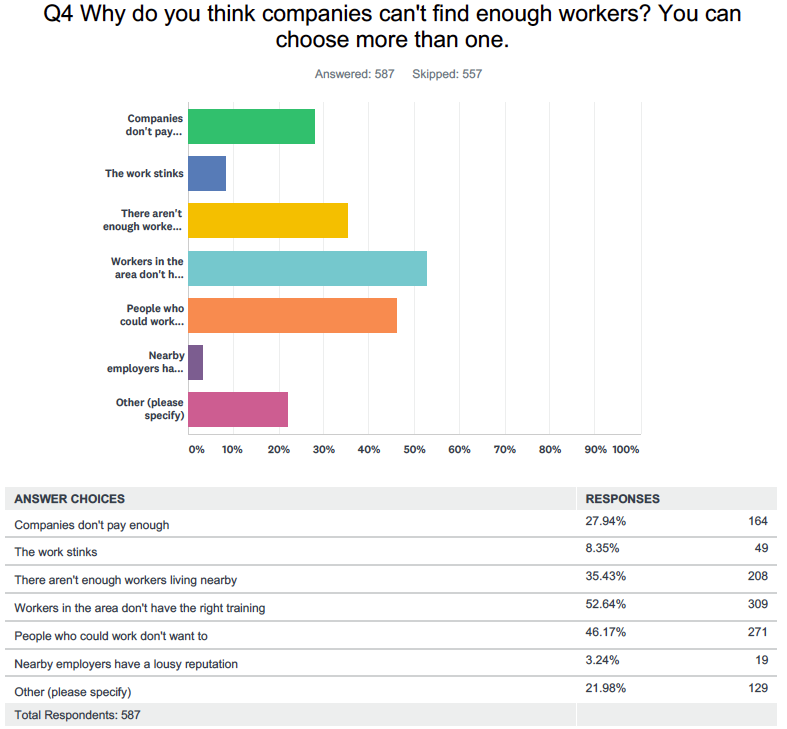A hidden threat to Trump’s economic agenda
Carlos Soto, owner of a floral service called Flowers From Our Heart, had an unexpected problem on the busiest day of the year: He had to turn down business on Valentine’s Day because he couldn’t find enough workers to field all the orders he could have taken.
“A year or two ago, I’d put an ad on Craigslist and get 100 or 150 resumes for a few positions,” says Soto, whose Los Angeles-based service delivers flowers through a network of 30,000 local shops. “This year, I placed several ads and got very few people. I could have used another six people. I would have been able to take more orders.”
With the U.S. economy in its ninth year of expansion, employers are fretting about a problem that seemed unimaginable just a few years ago, in the aftermath of mass layoffs and the Great Recession: a shortage of workers, from unskilled laborers needed to hammer nails to programmers and developers able to build complex software. The unemployment rate is a low 4.1% and probably headed below 4% at some point this year. The Labor Department says there are nearly 6 million unfilled jobs in the U.S. economy, close to a record high.

For the first time ever, small-business owners said in a monthly survey dating to 1974 that the poor quality of labor is their biggest problem, rather than perennial gripes such as taxes, weak sales, costly health insurance or excessive regulation. In a recent survey of business owners by J.P. Morgan Chase, 54% said finding qualified workers would be a “top challenge” in 2018—10 points higher than the portion who felt that way last year.
Yahoo Finance surveyed more than 1,100 people who own or manage a business, and interviewed a variety of them in depth, to determine why there’s a shortage of workers, and what might be done about it. (Here are highlights from the survey.) Among our findings:
More than half of employers say they can’t find enough qualified workers
To lure workers, employers are raising pay and sweetening benefits–and they still can’t find people, in many cases
Businesses struggle to find workers able to show up on time, finish a shift and pass a drug test
Many businesses, like Carlos Soto’s floral service, are giving up work—and revenue—because they’re chronically understaffed
In some industries, employers fault lousy immigration policies—and feel President Trump is making the problem worse
Workers, for their part, blame companies for offshoring jobs, skimping on training and setting standards unrealistically high

A diminishing pool of workers
Economists emphasize that key data doesn’t yet show workers are scarce throughout the economy. Job growth remains strong, for instance, with employers creating more than 180,000 new jobs per month, on average, since the start of 2017. If workers were scarce everywhere, that monthly average would be lower, perhaps below 100,000. And pay hasn’t risen broadly throughout the economy, which is what normally happens when companies run short on staffing.
“Businesses are grumbling about the inability to find qualified workers,” says Ryan Sweet, director of real-time economics at Moody’s Analytics. “But it’s isolated and concentrated regionally. I think what’s happening is, it was easy to find qualified workers a few years ago. HR offices could wallpaper their offices with resumes. Now, it’s harder. The pool of available workers is diminishing.”
A widespread labor crunch could be coming in a few years, however, threatening Trump’s goal of achieving annual growth rates of 3% or higher. And anecdotal reports today might be the first real sign of trouble. Today’s hiring difficulties also highlight fissures in the economy and in society more broadly, including a failing education system in parts of the country, poor policymaking in Washington and even cultural and generational divisions. Such festering problems might finally be causing tangible economic damage.
A lack of basic skills
David Bird owns a construction firm in Lawrenceburg, Ky., called Bird, Pruitt and Associates, and says finding workers is the toughest it’s been since he started his company in 2000. He’s perennially short of roofers, framers, drivers and lesser-skilled laborers. “I can’t find anybody who can pass a drug test and show up for work,” he tells Yahoo Finance. “I haven’t hired anybody under 35 in two years who can read a tape measure and do a fraction in their head, to cut lumber to frame a house.” Couldn’t he train workers at rudimentary skills they ought to learn in high school? Not really. “I can’t be paying somebody $12 an hour on a customer’s construction site to teach them basic math,” he says.

Bird has raised pay by about 50% during the last five years, to attract better workers. Unskilled workers start at $10 per hour, about a buck more than at local-fast-food joints, and pay rises quickly for workers who stick around. Average pay is around $15 per hour, and up to $20 for those with higher skills. Yet Bird still struggles. “I’ve got a head mechanic who comes in between 12 and 1 every day, and I can’t fire him, because I can’t replace him,” Bird says. Last November, one worker quit and disappeared with a company truck, which took Bird two months to locate and reclaim. And there’s a limit to what Bird can pay, because he can’t easily pass on rising labor costs to customers. “There a lid on what I can charge, because there’s a lid on what my clients can pay for a chicken coop or porch addition, he says.” Bird has started hiring ex-cons, provided their past crimes weren’t too severe.
In theory, firms that can’t find workers will raise pay until it’s high enough that qualified workers show up, or go to the trouble to get qualified. “It absolutely doesn’t work that way in real life,” says Lori Hayes, co-owner of Calypso Kennels in Fredericksburg, Va. “A lot of people don’t really have a work ethic. They don’t understand that when you’re scheduled to work, you work.”
Jobs at the kennel start around $9 per hour for people with experience handling animals, and rise quickly to $10, $11 and $12 for workers who stick around. “Once I’ve trained ‘em, I’ll bump ‘em up,” Hayes says. “And I’ll bump, bump, bump.” Still, most workers are gone within a couple of weeks, and sometimes within a couple of shifts. “It probably takes 10 hires to get one that will last three months,” Hayes says. And hardly anybody gives two weeks’ notice any more. Mostly, they just stop showing up.
Economists point out that there are still an unusually large number of working-age Americans who aren’t working, sometimes described as the “reserve labor pool.” The labor force participation rate, which measures the portion of working age people who have a job or are looking for one, has fallen from a peak of 67.2% in 1997 to 62.7% today. Nicholas Eberstadt of the American Enterprise Institute estimates that 7 million men between the ages of 25 and 54 could be working, but aren’t even looking for a job. Possible reasons: drug and alcohol addiction, families willing to support them, government benefits that discourage work, or mere lack of interest.
Immigration policy problems
To help push growth to 3% or higher, Trump signed legislation at the end of 2017 slashing the corporate tax rate from 35% to 21%, with the tax cut meant to give firms of all types more incentive to invest and do business in the United States. But many of the businesses Trump is relying on to amp up spending already face a shortage of workers, and they’ll have a hard time investing more if there’s nobody to do the work.
Apple, for instance, said it will boost spending in the U.S. on account of the tax cut, as did other big tech firms. But there’s an acute shortage of workers in parts of the tech industry. “If you talk to the Apples and Facebooks of the world, their business is almost being strangled by this lack of manpower,” says Daniel Webster, owner of Lakewood Ranch Search and Recruiting, near Sarasota, Fla. Webster recruits tech workers for firms all over the country, typically for jobs paying well over $100,000. Some companies give up finding needed workers and meld two jobs into one. Others raid workers from nearby employers, in a kind of escalating arms race for talent. “The Trump administration hasn’t thought this through, and that’s an understatement,” Webster says.
Tech firms strongly favor an increase in the number of H1-B visas that let foreign workers come to the United States to fill jobs when Americans workers aren’t available. The current limit on H1-Bs is 85,000 visas per year. But Trump favors less immigration, not more, and he’s reviewing the H1-B program to assure it’s not being abused. Some news reports suggest Trump is tacitly putting new limits on H1-Bs by making it harder to qualify for them. His strident anti-immigration rhetoric has also spooked foreigners who have work visas, or might apply. “The Trump administration has scared the bejesus out of these people,” says Webster. “They don’t know if they will be allowed to stay, or if they go home for vacation, they’ll be able to get back into the U.S.”
Immigration policy comes up frequently when employers suggest ways to ease the shortage of workers. “We used to get a lot of Hispanics coming here to help with the work force, but we just don’t see that any more,” says Tim Colstrup, owner of Colstrup Sod Farm in Ellandale, Minn., about 30 miles south of Minneapolis. “They were good workers. I don’t mean to put down the white laborers, but a lot of the time, they won’t do the work the minorities or the Hispanics were doing.”
Colstrup says he’s having the toughest time finding workers in the 32 years his company has been around. He has automated parts of the farming operation where he can. But he still needs workers for plantings at construction sites. Like other employers, he has raised pay—with little to show for it except higher payroll expenses. “Workers say, ‘that’s good pay,’ but some of them still only work a few days,” Colstrup says. “I don’t get it. Where is the drive to better yourself?”

David Bird, who owns the construction firm in Kentucky, also cited immigration when asked what might ease the labor shortage in his area. “Our immigration policy is not working,” he says. “The American capitalistic system has depended on first-generation immigrants to do manual labor and entry-level jobs. Our current policy is a financial and paperwork disaster.” He cites Trump’s anti-immigration rhetoric, along with a thicket of federal, state and local requirements for legally hiring migrant workers. “I’ve got a bachelor’s and a master’s degree,” he says, “and I can’t figure it out.”
It’s only going to get worse
Workers, not surprisingly, are more likely to blame employers for problems filling the ranks. In the Yahoo Finance survey, conducted Jan. 29-30, 51% of business owners and managers said there’s a shortage of workers in their area, but only 37% of workers felt that way. Business owners said the main problem is that workers are unqualified. Workers said the biggest problem is companies don’t pay enough. Management and labor always see things differently, needless to say, a gap that persists even amid low unemployment. (Here are our detailed survey results.)
Policymakers haven’t had much to say about the state of America’s workforce, and Congress isn’t seriously considering any legislation that would address the problems employers complain about. But on the front lines, there are signs the problem may worsen to the point that it impedes economic growth, possibly prompting government action.
“I think it’s going to get worse,” says Jeremy Boka, director of business development and sales for Perficut Site Management, a landscaping company based in Des Moines, Iowa. “If we had the people, the economy would be able to spin faster.”
Perficut has about 30 open positions it’s struggling to fill, including field laborers, foremen, superintendents and managers. A dearth of workers is now cutting into revenue growth. “We are going to have to be extraordinarily selective on what jobs we move forward with,” Boka says. “If we could get more people, we could grow 10% more this year.” The outlook, however, suggests workers will become even harder to hire, not easier. Tech companies such as Apple, Facebook and Google are expanding in the area, and billions of dollars’ worth of new construction projects are underway. Those are all signs the competition for workers will intensify. As problems go, it’s a good one to have. But it’s still a problem, and it’s getting bigger.
Confidential tip line: rickjnewman@yahoo.com. Encrypted communication available.
Health care costs are going to sting more
Rick Newman is the author of four books, including Rebounders: How Winners Pivot from Setback to Success. Follow him on Twitter: @rickjnewman
Follow Yahoo Finance on Facebook, Twitter, Instagram, and LinkedIn

